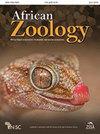Teratological Cases of the Ocular Patterns in the South African Endemic Trapdoor Spider Genus Stasimopus Simon (1892) (Araneae, Mygalomorphae, Stasimopidae)
IF 0.5
4区 生物学
Q4 ZOOLOGY
引用次数: 2
Abstract
Teratology is the science that deals with the causes and patterns of deformities, abnormalities and defects in the physical development of animals. Teratological occurrences can be due to genetic or environmental conditions. Ocular teratologies are common in hypogean spiders. This communication reports on the occurrence of ocular teratologies of the South African endemic spider family, Stasimopidae. A total of 212 spiders from various museum collections were examined for cases of ocular teratologies. Six females and one male were found to display some form of teratology. The species found to exhibit these were Stasimopus patersonae, S. robertsi, S. insculptus peddiensis, S. griswoldi, and three unidentified specimens. The teratologies range from reduced eye size to numerous additional eyes. The exact cause of the teratologies is unknown. They could, however, be linked to embryonic trauma or developmental issues, juvenile injury, or unusual environmental conditions during embryonic development. The spiders all survived to adulthood, as in hypogeal spiders eye sight is not the most relied on sense. Understanding the causes of teratologies is important as it may enable researchers to predict the effect of increasing chemical use and global climate change on the embryology of spiders.南非特有陷阱蛛属Stasimopus Simon(1892)(蛛形目,Mygalomorphae,Stasimopidae)眼型畸形病例
畸形学是一门研究动物身体发育中畸形、畸形和缺陷的原因和模式的科学。致畸的发生可能是由于遗传或环境条件。眼畸形在下海蜘蛛中很常见。本通讯报告了南非特有的蜘蛛家族,Stasimopidae的眼部畸形的发生。研究人员对来自不同博物馆的212只蜘蛛进行了眼部畸形检查。六名女性和一名男性被发现表现出某种形式的畸形。发现的具有这些特征的物种有:帕氏Stasimopus patersonae、S. robertsi、S. insculptus peddiensis、S. griswoldi和3个未确定的标本。畸形的范围从缩小的眼睛大小到许多额外的眼睛。造成畸形的确切原因尚不清楚。然而,它们可能与胚胎创伤或发育问题、幼年损伤或胚胎发育期间的异常环境条件有关。这些蜘蛛都活到了成年,因为在水下蜘蛛中,视力不是最依赖的感官。了解致畸的原因很重要,因为它可以使研究人员预测化学品使用增加和全球气候变化对蜘蛛胚胎学的影响。
本文章由计算机程序翻译,如有差异,请以英文原文为准。
求助全文
约1分钟内获得全文
求助全文
来源期刊

African Zoology
生物-动物学
CiteScore
2.60
自引率
9.10%
发文量
18
审稿时长
>12 weeks
期刊介绍:
African Zoology , a peer-reviewed research journal, publishes original scientific contributions and critical reviews that focus principally on African fauna in terrestrial, freshwater, and marine ecosystems. Research from other regions that advances practical and theoretical aspects of zoology will be considered. Rigorous question-driven research in all aspects of zoology will take precedence over descriptive research. The Journal publishes full-length papers, critical reviews, short communications, letters to the editors as well as book reviews. Contributions based on purely observational, descriptive or anecdotal data will not be considered.
The Journal is produced by NISC in association with the Zoological Society of South Africa (ZSSA). Acceptance of papers is the responsibility of the Editors-in-Chief in consultation with the Editors and members of the Editorial Advisory Board. All views expressed are those of the author and not necessarily those of the Editors or the Department.
 求助内容:
求助内容: 应助结果提醒方式:
应助结果提醒方式:


